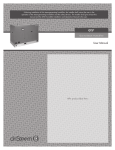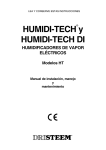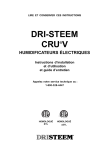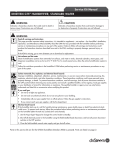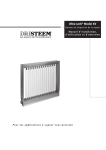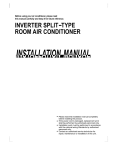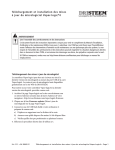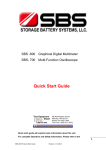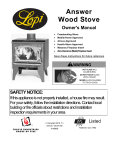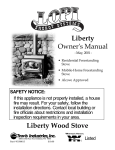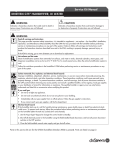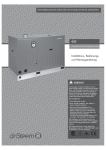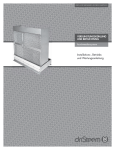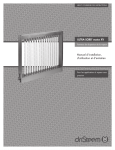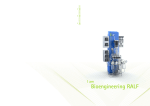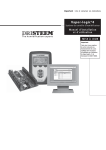Download Europe Installation and Operation Manual
Transcript
Following installation of this steam-generating humidifier, the installer shall instruct the user in the operation of the steam-generating humidifier and the safety devices. The installer shall give at least this manual and the GTS Humidifier User Manual to the user. GTS® Gas-to-Steam Humidifier Installation and Operation Manual Affix product label here. Table of contents Before you begin . . . . . . . . . . . . . . . . . . . . . . . . . . . . . . . . . . . . . . . . 1 Safeguards . . . . . . . . . . . . . . . . . . . . . . . . . . . . . . . . . . . . . . . . . . . . 2 Product overview . . . . . . . . . . . . . . . . . . . . . . . . . . . . . . . . . . . . . . . . 3 The Vapor-logic5 Installation and Operation Manual is a comprehensive manual. Refer to it for: • Setup and menu information • Input signals and functions Finding a location . . . . . . . . . . . . . . . . . . . . . . . . . . . . . . . . . . . . . . . 4 • Alarms and messages Clearance recommendations . . . . . . . . . . . . . . . . . . . . . . . . . . . . . . . . 4 •Troubleshooting • Firmware updates Outdoor enclosure recommendations . . . . . . . . . . . . . . . . . . . . . . . . . . 4 • Safety features Wiring and supply water piping requirements Wiring . . . . . . . . . . . . . . . . . . . . . . . . . . . . . . . . . . . . . . . . . . . . . . 5 Supply water piping requirements for all water types . . . . . . . . . . . . . 5 The manual was shipped with your humidifier. It is also available on our website: www.dristeem.com Supply water piping Tap/softened water . . . . . . . . . . . . . . . . . . . . . . . . . . . . . . . . . . . . . RO/DI water option . . . . . . . . . . . . . . . . . . . . . . . . . . . . . . . . . . . . Supply water flow rates . . . . . . . . . . . . . . . . . . . . . . . . . . . . . . . . . . Supply water guidelines . . . . . . . . . . . . . . . . . . . . . . . . . . . . . . . . . . 6 6 6 6 Drain piping . . . . . . . . . . . . . . . . . . . . . . . . . . . . . . . . . . . . . . . . . . . 7 Gas piping . . . . . . . . . . . . . . . . . . . . . . . . . . . . . . . . . . . . . . . . . . . . 8 Combustion and ventilation air Room air combustion . . . . . . . . . . . . . . . . . . . . . . . . . . . . . . . . . . . 10 Sealed combustion . . . . . . . . . . . . . . . . . . . . . . . . . . . . . . . . . . . . . 11 Venting General venting guidelines . . . . . . . . . . . . . . . . . . . . . . . . . . . . . . Outdoor enclosure venting . . . . . . . . . . . . . . . . . . . . . . . . . . . . . . . Vertical venting requirements . . . . . . . . . . . . . . . . . . . . . . . . . . . . . Horizontal venting requirements . . . . . . . . . . . . . . . . . . . . . . . . . . . 12 12 13 13 Operation Start-up checklist . . . . . . . . . . . . . . . . . . . . . . . . . . . . . . . . . . . . . . 14 Start-up . . . . . . . . . . . . . . . . . . . . . . . . . . . . . . . . . . . . . . . . . . . . . 14 Maintenance Cool-down procedure . . . . . . . . . . . . . . . . . . . . . . . . . . . . . . . . . . 15 Shutdown procedure: . . . . . . . . . . . . . . . . . . . . . . . . . . . . . . . . . . . 15 Inspection and maintenance . . . . . . . . . . . . . . . . . . . . . . . . . . . . . . 15 Inspection recommendations RO/DI water quality recommendations . . . . . . . . . . . . . . . . . . . . . . Inspection intervals . . . . . . . . . . . . . . . . . . . . . . . . . . . . . . . . . . . . Inspection items . . . . . . . . . . . . . . . . . . . . . . . . . . . . . . . . . . . . . . Burner assemblies and heat exchanger tubes . . . . . . . . . . . . . . . . . . Burner maintenance frequency . . . . . . . . . . . . . . . . . . . . . . . . . . . . Burner maintenance instructions . . . . . . . . . . . . . . . . . . . . . . . . . . . 17 17 17 18 18 18 Burner tuning . . . . . . . . . . . . . . . . . . . . . . . . . . . . . . . . . . . . . . . . . 19 Warranty . . . . . . . . . . . . . . . . . . . . . . . . . . . . . . . . . . . . . . Back cover ii DRISTEEM GTS HUMIDIFIER INSTALLATION AND OPERATION MANUAL •Options Before you begin Electrical warning label Location: Front door and electrical access door Definition: Electrical shock hazard Important: This equipment is for use with the following appliance categories. Contact your distributor before converting to another group or supply pressure. An input derate exists when operating GTS humidifiers at a high altitude. This equipment has been tested by Intertek to the Low Voltage, Gas Appliance, and EMC directives and has been certified by Certigaz for use in all EU countries. Table 1-2: Input derate for high altitude Altitude (meters) Input derate % GTS humidifiers bearing the CE mark are authorized for use in the European countries listed below. 0 – 610 0 611 – 765 2 766 – 915 4 916 – 1065 6 Table 1-3: Authorized countries of destination 1066 – 1220 8 Austria (AT) Latvia (LV) 1221 – 1370 10 Belgium (BE) Lithuania (LT) 1371 – 1525 12 Bulgaria (BG) Luxembourg (LU) I2H G20 at 20 mbar 1526 – 1675 14 Cyprus (CY) Malta (MT) I2E G20 at 20/25 mbar 1676 – 1830 16 Czech Republic (CZ) Netherlands (NL) I2E+ G20/G25 at 20/25 mbar 1831 – 1980 18 Denmark (DK) Norway (NO) I2L G25 at 25 mbar 1981 – 2135 20 Estonia (EE) Poland (PL) I3+(28-30/37) G30 Butane at 28-30 mbar and G31 Propane at 37 mbar 2136 – 2285 22 Finland (FI) Portugal (PT) 2286 – 2440 24 France (FR) Romania (RO) 2441 – 2590 26 Germany (DE) Slovakia (SK) 2591 – 2743 28 Greece (GR) Slovenia (SI) 2744 – 2895 30 Hungary (HU) Spain (ES) 2896 – 3048 32 Iceland (IS) Sweden (SE) I3P(30) G31 Propane at 30 mbar 3049 – 3200 34 Ireland (IE) Switzerland (CH) I3P(37) G31 Propane at 37 mbar 3201 – 3352 36 Italy (IT) United Kingdom (GB) I3P(50) G31 Propane at 50 mbar 3353 – 3505 38 3506 – 3657 40 Table 1-1: Appliance categories I3B/P(30) G30 Butane and G31 Propane at 30 mbar I3B/P(37) G30 Butane and G31 Propane at 37 mbar I3B/P(50) G30 Butane and G31 Propane at 50 mbar Table 1-4: Gas specifications for GTS models Volumetric flow rate by gas category GTS model 2H-G20-20 mbar 2L-G25-25 mbar 3P-G31-30 mbar 2E-G20-20 mbar 2LL-G25-20 mbar 2E+G20/G25-20/25 mbar 3B-G30-30 mbar 3P-G31-37 mbar 2Es-G20-20 mbar 2Ei-G25-25 mbar 2ER-G20/G25-20/25 mbar 3B-G30-50 mbar 3P-G31-50 mbar Average flue temperature at 100% demand Minimum draught requirement Mass flow rate of combustion products 100 2.31 m3/h 2.82 m3/h 2.31-2.82 m3/h 1.31 m3/h 1.49 m3/h 200 °C – 0.025 mbar 6.9 g/s 200 4.62 m3/h 5.64 m3/h 4.62-5.64 m3/h 2.62 m3/h 2.98 m3/h 220 °C – 0.025 mbar 13.8 g/s 300 6.93 m /h 8.46 m /h 6.92-8.46 m /h 3.93 m /h 4.47 m /h 190 °C – 0.025 mbar 20.7 g/s 400 9.24 m /h 11.28 m /h 9.24-11.28 m /h 5.24 m /h 5.96 m /h 220 °C – 0.025 mbar 27.6 g/s 500 11.55 m /h 14.10 m /h 11.55-14.10 m /h 6.55 m /h 7.45 m /h 220 °C – 0.025 mbar 34.5 g/s 600 13.86 m3/h 16.92 m3/h 13.85-16.92 m3/h 7.86 m3/h 8.94 m3/h 220 °C – 0.025 mbar 41.4 g/s 700 16.17 m3/h 19.74 m3/h 16.17-19.74 m3/h 9.17 m3/h 10.43 m3/h 220 °C – 0.025 mbar 48.3 g/s 800 18.48 m3/h 22.56 m3/h 18.47-22.56 m3/h 10.48 m3/h 11.92 m3/h 220 °C – 0.025 mbar 55.2 g/s 3 3 3 3 3 3 3 3 3 3 3 3 3 3 3 DRISTEEM GTS HUMIDIFIER INSTALLATION AND OPERATION MANUAL 1 Safeguards The GTS humidifier has a number of safeguards to ensure proper operation: • When there is a call for humidity, all of the combustion blowers must start. Each combustion blower sends a signal to the microprocessor relaying its speed. If the speed is outside an acceptable range, the GTS will not operate. • The negative-pressure gas valves used on the GTS humidifier are designed to keep a constant ratio of air and gas throughout the operating range of the blower. If the blower fails to run, the GTS humidifier will shut down due to a blower fault. • If the flue becomes blocked, the blocked flue sensor will shut down the humidifier. • During operation, the water level in the tank is monitored by a probe system for tap/softened water humidifiers and by a low water float switch for humidifiers with the RO/DI water option (see Figure 3-1). These water level monitors tie into the Vapor‑logic controller. If the water level drops below a safe point, the controller turns the burners off and tries to fill the tank. If unable to fill the tank within a defined time period, an “Excessive refill time” alarm appears in the Vapor-logic Alarm Log. The burners remain off until this alarm is cleared. • In tap/softened water applications, the water level in the tank is also monitored by a redundant low-water system that operates independently of the Vapor‑logic controller. This system is tied directly into the power source for the gas valves. If this system detects a low water condition, the humidifier shuts down until water is present. A “GTS low water alarm” will be active while the condition exists. • There is a temperature sensor near the top of the heat exchanger. If the water level drops too low and both the main and redundant low water sensors fail to detect it, the temperature sensor shuts down the humidifier to prevent an unsafe condition. • There is a limit-control thermal trip next to the temperature sensor. This thermal trip operates independently from the Vapor-logic controller. If the water level drops below the heat exchanger, the thermal trip will directly shut down the gas valves. The thermal trip has a red button that must be manually reset before the burners are able to fire again. 2 DRISTEEM GTS HUMIDIFIER INSTALLATION AND OPERATION MANUAL Product overview FIGURE 3-1: GTS HUMIDIFIER COMPONENTS AND WATER LEVEL CONTROL TYPES Tap/softened water DI/RO water option Humidifiers using tap or softened water control water levels electronically using a three-rod probe. A redundant probe is used as a safety device. Humidifiers with the RO/DI water option control water level using a float valve. A low-water cutoff switch and a redundant low-water cutoff switch are used as safety devices. Fill valve Float Fill valve closes when water level rises to this probe. Fill valve opens when water level is below this probe. Controller disables burner if water level drops below this probe. Heat exchanger Steam hose or tubing Water level probe (Float-operated low water cutoff switch if DI/RO water option) Steam outlet Overflow outlet Redundant probe (Redundant low water cutoff switch if DI/RO water option) Thermal trip Temperature sensor Flue connection Blower Subpanel/control components Gas valve Supply water line Drain valve Water tempering device Drain piping Air gap OM-1247 Open drain Tap/softened water GTS humidifier shown DRISTEEM GTS HUMIDIFIER INSTALLATION AND OPERATION MANUAL 3 Finding a location WARNING Installation requirements: Installation must conform to the requirements of local and national directives and regulations for the installation of gas-fired equipment. The humidifier must be installed by a qualified technician and meet the requirements of all governing codes. Failure to follow these instructions could cause severe bodily injury or death. • Provide a level, solid foundation for the humidifier. • Locate the humidifier as near as possible to a chimney or outside wall so that the flue pipe from the humidifier is short and direct. • Install the humidifier where its electrical components are protected from water during operation and service. • Install the humidifier in a location away (and protected) from drafts. If installed in a separate room, follow the instructions concerning combustion and ventilation air. • Install the humidifier in an area where leakage from the tank or its connections will not result in damage to the adjacent structure or to lower floors of the structure. When such locations cannot be avoided, install a suitable drain pan (adequately drained) under the humidifier. The pan must not restrict combustion airflow. • If located in an insulated space, keep the humidifier free and clear of insulating materials. Insulating material can be combustible. Inspect the humidifier area when the humidifier is installed or when insulation is added. FIGURE 4-1: CLEARANCE RECOMMENDATIONS 460 mm FIGURE 4-2: OUTDOOR ENCLOSURE RECOMMENDATIONS Back panel: No ventilation louvers 75 mm Vent cap Flue piping Vertical section of flue must be at least 1.5 meters or meet all governing codes, whichever is longer. DriSteem recommends installing a high-wind vent cap on all GTS humidifiers. Clearance required behind outdoor enclosure for steam outlet 920 mm GTS humidifier back panel Side door: Electrical access 760 mm Outdoor enclosure back wall OM-1222 Front door: Burner, blower, gas valve, and plumbing access OM-1228LW • DriSteem recommends 25 mm minimum clearance between back panel and combustible surfaces. • These clearance recommendations are provided to provide access and to prevent property damage from heat. To further safeguard property, protect heat-sensitive walls and surfaces (wood, plastic, etc.) with suitable insulation. 4 DRISTEEM GTS HUMIDIFIER INSTALLATION AND OPERATION MANUAL Wiring and supply water piping requirements WIRING WARNING Installation must meet the requirements of governing codes or, in the absence of governing codes, in accordance with IEE wiring regulations (BS7671). Failure to follow these instructions could cause a fire, resulting in severe bodily injury, death, or significant property damage. Follow the instructions below for GTS humidifier wiring: • Use only copper wire. • GTS humidifiers must be supplied with 230 Vac, 50 Hz, separately fused electrical service. • The electrical subpanel must have an uninterrupted earth ground to minimize personal injury if an electrical fault should occur. Install in accordance with existing electrical codes. • Do not use gas piping as an electrical earth ground. • All electrical components and wiring must be protected from mechanical damage and water. • Check the electric current characteristics and capacity requirements against the nameplate. All wiring must be in accordance with the governing codes listed above and with the GTS wiring diagrams. SUPPLY WATER PIPING REQUIREMENTS FOR ALL WATER TYPES Follow the GTS humidifier supply water piping instructions below for all water types. Install supply water piping in accordance with locally applicable installation regulations. • Provide a shutoff valve and union in the supply water line to isolate the humidifier from the water system while servicing. • To minimize electrolytic corrosion, install insulating unions to make connections between copper and other dissimilar metal fittings, such as galvanized steel. • Humidifier tank must be full of water — and supply water free to flow into the tank — before the ignition sequence of a newly installed humidifier is initiated. • If planning to use heated supply water, disconnect the supply water line from the water tempering device fill manifold/tee. Install a pipe plug in the manifold/tee, and reconnect the water tempering device line to a cold water supply. • The supply water pressure range must be 172 kPa minimum with fill valve open to 552 kPa maximum with fill valve closed. When using nonmetallic tubing for supply water, it must be rated for 100 °C minimum continuous operating temperature. DriSteem recommends installing a 1 m piece of noninsulated stainless steel pipe directly off the humidifier prior to connecting to the nonmetallic tubing. • Before connecting piping to the GTS humidifier, thoroughly flush the supply water piping to prevent pipe residue and stagnant water from getting into the humidifier tank. General supply water piping information: • The end-of-season feature shuts off the supply water and drains the tank when there is no demand for humidity for 72 hours. This is a default setting and is user‑adjustable. • The humidifier has a 25-mm internal air gap to prevent back siphoning into a potable water system. Some governing codes may require additional protection, such as a vacuum breaker or backflow preventer. • The supply water assembly has a DN10 pipe thread connection. DRISTEEM GTS HUMIDIFIER INSTALLATION AND OPERATION MANUAL 5 Supply water piping TAP/SOFTENED WATER SUPPLY WATER GUIDELINES The primary component of the supply water assembly is a solenoid valve, which may cause noise during fill cycles. Supply water quality is an important component of humidifier reliability and maintenance. During a fill cycle, cold supply water drops the internal tank temperature and may collapse the boil, which can cause a low rolling sound. To minimize this, use hot supply water. In cases where water hammer occurs when the fill solenoid closes, a shock arrester is recommended. Reducing the supply water pressure (minimum 172 kPa with fill valve open) or using flexible tubing (rated for 100 °C minimum continuous operating temperature) may diminish the noise. The minimum water conductivity for the GTS tap/softened water model is 30 µS/cm. Examples: • Corrosive water can decrease the service life of the humidifier. • Excessive water hardness can increase the humidifier maintenance requirements. To maximize humidifier service life and minimize humidifier maintenance, DriSteem has established guidelines for supply water See Table 6-1. RO/DI WATER OPTION The water level in GTS humidifiers with the RO/DI water option is controlled with a float valve. For models with the end‑of‑season drain option, a solenoid valve is installed prior to the float valve. When using nonmetallic tubing, DriSteem recommends the installer place a 50-mm water seal/loop in the supply water line to isolate steam during RO/DI water system maintenance. DriSteem highly recommends installing a strainer in the supply water line to prevent clogging of the solenoid valve or float valve orifice. The strainer prevents particulate from collecting at the solenoid valve seat. To minimize RO/DI water waste, disconnect factory piping to the water tempering device and pipe directly to a tap water source. Table 6-1: DriSteem supply water guidelines Chlorides* RO or DI water < 5 ppm Softened water < 25 ppm Tap water < 50 ppm *D amage caused by chloride corrosion is not covered by your DriSteem warranty. Total hardness WARNING Fire hazard if using tap/softened supply water with RO/DI water option: If a GTS humidifier with the RO/DI water option is supplied with tap/softened fill water, the float valve assembly will become clogged, and particulate will accumulate on the low water cutoff switch (float switch). This will cause failure of a critical safety circuit and the potential for a dry tank fire, which can cause severe property damage, severe personal injury, or death. SUPPLY WATER FLOW RATES The rate of supply water flow into the GTS humidifier tank is determined by the supply water pressure and the inlet valve. See Table 6-2. Table 6-2: Supply water flow rates (liters per minute) 6 Supply water pressure Solenoid valve flow rates (tap/softened water) 200 kPa Tap water pH RO, DI, or softened water Tap water Silica Models 100 – 400 Models 500 – 800 7.2 6.7 17.0 350 kPa 9.0 8.8 22.5 450 kPa 10.2 9.9 25.4 550 kPa 11.1 10.8 27.6 DRISTEEM GTS HUMIDIFIER INSTALLATION AND OPERATION MANUAL 7 to 8 6.5 to 8.5 < 15 ppm You may wish to take action to mitigate potential negative effects to your humidifier. Supply water outside of these guidelines may void your DriSteem warranty. Please contact your DriSteem distributor if you need advice. mc_071912_1545 Float valve flow rates (RO/DI water) < 500 ppm Drain piping The drain line piped from the humidifier must be run to an approved sanitary waste or suitable drain. Although the GTS humidifier is equipped with integral water tempering, if nonmetallic drain pipe or hose is used, DriSteem recommends it be rated for 100 °C minimum continuous operating temperature. • Minimum drain pipe size is DN40 inside diameter. Do not reduce the size of the drain piping. If the length of the drain piping exceeds 3 m, increase the pipe size. If combining multiple drain lines, ensure proper common pipe sizing practices are used. • Do not install the humidifier directly above a floor drain — skim and drain water dumped into the drain will cause flash steam, which will rise and saturate electrical components, adversely affecting their life and performance. • An open drain with a 25-mm air gap between the drain piping and the drain is required. Locate the air gap only in spaces with adequate temperature and air movement to absorb flash steam; otherwise, condensing on nearby surfaces may occur. • Drain piping downstream from the water seal must be pitched a minimum of 1% toward the drain. Governing codes may require more pitch. • If the proximity of a drain requires the humidifier drain and skim water to be lifted, use a water pump with capacity of at least 45.4 liters per minute. A check valve is required on the discharge of the pump. Electrical power for the pump is independent of the humidifier. • The GTS humidifier has an auxiliary DN40 drain outlet below the subpanel. This drain outlet can be hard-piped during installation to enable rapid tank draining before maintenance. Next to this outlet is a cleanout plate that provides access for removing scale from the tank bottom. DRISTEEM GTS HUMIDIFIER INSTALLATION AND OPERATION MANUAL 7 Gas piping Important: The required supply pressure is 20 or 25 mbar for natural gas and 30, 37, or 50 mbar for propane gas. WARNING Fire hazard: Supply the humidifier only with the gas type (natural gas or LP gas) listed on the humidifier name plate. Failure to supply the humidifier with the listed gas type could result in burner failure or a fire, causing property damage, personal injury, or death. Follow the GTS humidifier gas piping instructions below. Conform to local and national directives and regulations for the installation of gas-fired equipment. • After threading and reaming ends of pipes, inspect piping and remove loose dirt and chips. • Support piping so there are no strains imposed on humidifier or controls. • Use two wrenches when connecting piping to humidifier or controls. • Provide a drip leg before each humidifier and in the line where low spots cannot be avoided. • Take-off to humidifier should come from top or side of main to avoid trapping condensate. • Piping that is subject to wide temperature variations should be insulated. • Pitch piping up toward humidifier at least 6 mm per 4.5 m of horizontal run. • Compounds used on threaded joints of gas piping must be resistant to the harmful action of liquefied petroleum gases. • Install a ground joint union and a manual shutoff valve immediately upstream of the humidifier. • Do not use flexible connectors. • Allow at least 1.5 m of piping between any high pressure regulator and humidifier pipe connection. • Piping installation must conform to the requirements of the authority having jurisdiction or, in the absence of such requirements, must conform to local and national directives and regulations for the installation of gas-fired equipment. 8 DRISTEEM GTS HUMIDIFIER INSTALLATION AND OPERATION MANUAL Gas piping • When the specific gravity of the gas is other than 0.60 for natural gas or 1.53 for propane, refer to Table 9-1. • Piping to GTS humidifiers should conform with local and national requirements for type, volume, and gas handled and for pressure drop allowed in the line. Refer to the tables on this page to determine the gas flow in m3/hr for the type of gas and size of humidifier to install. Using this value and the length of pipe necessary, determine the pipe diameter. Where several GTS humidifiers are served by the same main, the total capacity, gas flow, and length of main must be considered. Avoid pipe sizes smaller than DN15. Table 9-2 allows for the usual number of fittings with a 0.7 mbar pressure drop. WARNING Fire or explosion hazard: Purge air before lighting humidifier burners by disconnecting piping at gas control. In no case should line be purged into heat exchanger. Failure to follow these instructions could cause a fire or explosion, resulting in bodily injury, death, or significant property damage. Gas pressure test gauge Install a DN6 plugged tapping, accessible for test gauge connection, immediately upstream of the gas supply connection to the appliance. Use this tap to check pressure with all burners running. Leak testing After installation, check field piping and humidifier gas train for gas leaks. • Do not use soap solution or open flame on humidifier gas train. A gas leak detector is recommended. • When leak-testing the gas supply piping system, isolate the humidifier from the gas supply piping system by closing its field-installed manual shutoff valve whenever pressure is greater than 60 mbar. Table 9-1: Specific gravity conversion factors Table 9-2: Gas pipe capacities for gas pressures of 3.45 kPa or less Natural gas Specific gravity Factor 0.55 1.04 0.60 1.00 0.65 0.962 Propane gas Specific gravity Factor 1.50 0.633 1.53 0.626 1.60 0.612 Note: U se the above multiplying factor with Table: 9-2 when the specific gravity of gas is other than 0.60 (natural gas) or 1.53 (propane). Gas flow in piping in m3/hr at pressure drop of 0.07 kPa Specific gravity = 0.60 Length of pipe Nominal iron pipe diameter in inches (DN) DN15 DN20 DN25 DN32 DN40 m m3/hr m3/hr m3/hr m3/hr m3/hr 3 3.7 7.9 14.7 29.7 45.3 6 2.6 5.4 9.9 20.7 31.1 9 2.1 4.3 8.1 16.7 25.2 12 1.8 3.7 6.9 14.2 21.5 15 1.6 3.3 6.1 12.5 19.0 18 1.4 3.0 5.5 11.3 17.3 21 1.3 2.7 5.1 10.5 15.9 24 1.2 2.5 4.8 9.9 15.0 27 1.1 2.4 4.5 9.1 13.9 30 1.1 2.2 4.2 8.6 13.0 DRISTEEM GTS HUMIDIFIER INSTALLATION AND OPERATION MANUAL 9 Combustion and ventilation air The GTS humidifier supports both room air and sealed combustion. • Do not install the humidifier in a dusty environment. • When the GTS humidifier is installed in an environment with negative pressure or toxic air, it must have sealed combustion. ROOM AIR COMBUSTION WARNING Air for combustion: Air for combustion must not be contaminated by halogen compounds, which include fluoride, chloride, bromide, and iodide. These elements are found in aerosol sprays, detergents, bleaches, cleaning solvents, salts, air fresheners, and other household products. Failure to follow these instructions could cause severe bodily injury or death. • All fuel-burning equipment must be supplied with air for combustion. Sufficient air must be provided to ensure there is not a negative pressure in the equipment room or space. • Do not block or obstruct air openings on the appliance, spaces around the appliance, or air openings to the appliance area. • Do not block the flow of combustion and ventilation air. To provide necessary oxygen for proper combustion, openings must be provided to allow outside air to enter the space where the humidifier is located. Enclosed spaces, such as equipment rooms, must be vented for combustion air. The size of air openings must be based on all gasburning equipment installed in the space. Table 10-1 outlines four types of locations, and the requirements of each. Table 10-1: Location of humidifier and required air openings Location description Confined space with all air from inside the building; conventional frame, brick or stone construction with normal infiltration Required air opening Two openings, 6.5 cm2 per opening per 293 W input The minimum free area of all openings combined is 645 cm2. Note: this location rarely provides enough air for higher-capacity humidifiers. Confined space with all air from outside the building through air ducts Two openings, 2 ducts, 6.5 cm2 per opening per 586 W input* Confined space with all air from outside the building from through-wall openings only (no ducts) Two openings, 6.5 cm2 per opening per 1172 W input* Unconfined space with all air from outside the building Same as confined space; all air from outside the building * The minimum dimension of any opening is 76 mm × 76 mm. 10 DRISTEEM GTS HUMIDIFIER INSTALLATION AND OPERATION MANUAL Combustion and ventilation air SEALED COMBUSTION WARNING Requirement for manifolding sealed combustion piping runs: When installing sealed-combustion piping for more than one GTS humidifier, do not commonly manifold multiple sealed combustion piping runs without having the manifold sized for the specific installation by a licensed engineer. Failure to follow these instructions could starve the GTS humidifier of combustion air resulting in either the burners not being able to light or high carbon monoxide levels, which may cause severe personal injury or death. The GTS humidifier supports sealed combustion using DN100 PVC or CPVC piping. All GTS models have a single-point connection to the blower inside the front door. See Figure 11-3. When running PVC or CPVC piping for sealed combustion, the maximum allowable distance to the outdoor air source is 21.3 m including 2.1 m equivalent length for each elbow. The outside air source opening must be covered with a large mesh screen to prevent the introduction of unwanted materials without restricting airflow. If sealed combustion piping is less than 6 m in length, DriSteem recommends insulating the piping to prevent condensation. SEALED COMBUSTION OR OUTDOOR ENCLOSURE To ensure a supply of clean, fresh air, the GTS humidifier combustion air must be at least 3 m away from any mechanical exhaust outlet. FIGURE 11-3: GTS OPTIONAL SEALED COMBUSTION CONNECTION OM-1225 Front door DN100 PVC or CPVC combustion air intake DRISTEEM GTS HUMIDIFIER INSTALLATION AND OPERATION MANUAL 11 Venting GENERAL VENTING GUIDELINES WARNING Installation requirements: The humidifier must be installed by a qualified technician and meet the requirements of all governing codes. Failure to follow these instructions could cause severe bodily injury or death. • The GTS humidifier is a Fan Assisted Category I (natural draft) Appliance. It is a Class B23 appliance, without a draught diverter, with a combustion air blower upstream of the heat exchanger. A GTS humidifier with the sealed combustion option is a Class C53 appliance. Installations where the vent terminates in a side wall of the building, or where the overall horizontal run exceeds the overall vertical run, require a power venter. • Maximum flue temperature under normal operating conditions is 205 °C plus ambient. • Maximum abnormal-operation flue temperature is 348 °C plus ambient. • Flue draft negative pressure greater than 50 Pa may cause unacceptable post ignition. • Vent piping must be approved for a Category I appliance. Do not use more than one type of venting per application. • Vent terminal must be at least 1 m above any forced air inlet located within 3 m. • Do not use vent equipment from more than one manufacturer. • When connecting the humidifier to a gas vent or chimney, installation must conform to: – Local and national directives and regulations for the installation of gas-fired equipment – Governing and building codes – Vent manufacturer’s instructions • When applying the codes, see also the venting manufacturer's instructions, the service gas supplier's regulations, and the specific instructions provided in this manual. • Inspect for proper and tight construction. Remove any restrictions or obstructions. An existing chimney may require cleaning. • Do not connect this humidifier to a chimney flue servicing a separate appliance designed to burn solid fuel. • Never connect this humidifier to a chimney serving a fireplace, unless the fireplace opening is permanently sealed off. • Code prohibits venting into an unlined masonry or concrete chimney. If the humidifier is connected to a lined, masonry chimney, the chimney must be sized and installed according to the provisions of the governing codes. 12 DRISTEEM GTS HUMIDIFIER INSTALLATION AND OPERATION MANUAL • Vent connector serving this appliance shall not be connected into any portion of mechanical draft systems operating under positive pressure. • Add insulation to any roof or wall penetration vent connector that is exposed to ambient temperatures of 0 °C or less, especially any application using singlewall vent pipe as a connector. • Do not insulate vent pipe exposed to outdoor weather conditions (e.g., above roof lines). • Install vent piping as straight as possible, with a minimum number of turns or elbows. • Maintain a minimum upward slope of 2% on all horizontal runs. • Rigidly support the vent pipe every 1.5 m or less with hangers or straps to ensure there is no movement after installation. The humidifier vent box should not support the weight of the vent piping. • No portion of the vent system should extend into, or pass through, any circulation air duct or plenum. • Install and fire-stop all vent pipe passing through floors, ceilings, and walls with the proper clearances from combustible material according to local and national directives and regulations for the installation of gas-fired equipment. • In replacement installation where an existing vent system may be used, inspect the vent system for condition, size, type of vent material, and height to meet the requirements in these instructions. CAUTION Flue condensate removal Install a drip leg or flue box condensate drain for startup flue condensate removal. Failure to follow these instructions could cause water to accumulate in the flue box. OUTDOOR ENCLOSURE VENTING The vertical section of flue must be at least 1.5 meters or meet all governing codes, whichever is longer. DriSteem recommends a drip tee directly after the factory-supplied vent connection. DriSteem recommends a high-wind vent cap on all GTS humidifiers. See Figure 4-2. Venting VERTICAL VENTING REQUIREMENTS • Do not reduce the vent diameter. • If turns are required in the vent piping, make sweeping bends; avoid small-radius turns. HORIZONTAL VENTING REQUIREMENTS • Contact your DriSteem distributor for all horizontal venting parts. • Maintain proper support of vent connections and joints. • Ensure that distances from vent terminal to adjacent public walkways, buildings, and openable windows and building openings are consistent with local and national directives and regulations for the installation of gas-fired equipment. • Observe clearances (in accordance with applicable codes) from all combustible materials and install an approved cap for the stack outlet. • In areas accessible to the public, vent terminal must be at least 2.1 m above ground level to prevent burns from hot terminal surface. • The bottom of the cap must be one stack diameter above the top of the stack. • The vent terminal and air intake locations must be at sufficient height above ground level to prevent blocking by expected snowfall. • Use the same size stack as the vent furnished with the humidifier. • Extend chimney or vent at least 1 m above its passage through a roof and at least 0.6 m above any ridge within 3 m of the chimney (governing codes apply). • The vent system must terminate above the roof surface per the local and national directives and regulations for the installation of gas-fired equipment. DriSteem recommends installing a high-wind vent cap on all GTS humidifiers. • This humidifier may be commonly vented with other listed Category I gas‑fired appliances. Total input rates of all appliances determines the vent size. • Maintain minimum horizontal clearance of 1.2 m from electric meters, gas meters, regulators, and relief equipment. • Building materials must be protected from degradation by flue gases. • Vent box pressure must be –2.5 Pa. Set by adjusting power venter and barometric damper with all burners running (see manufacturer's instructions included with power venter and damper). WARNING Horizontal venting with a vertical termination: For applications where the vent pipe terminates in a vertical position, the horizontal length must not exceed the height of the vent unless a power venter is used. Failure to follow these instructions could cause flue gases to exit the vent piping, causing severe personal injury or death. DRISTEEM GTS HUMIDIFIER INSTALLATION AND OPERATION MANUAL 13 Operation START-UP CHECKLIST After the system is installed and connected to gas, electrical, water supplies, and controls, check the following items: ☐ Verify that the GTS humidifier, controls, piping, electrical connections, steam supply, and dispersion units are installed according to the following: • Installation instructions in this manual • Vapor-logic version 5 Installation and Operation Manual (shipped with the humidifier) – Installation section – Installation checklist • Ladder style wiring diagram (shipped inside humidifier) • External connections wiring diagram (shipped inside humidifier) • Gas connection instructions in this manual • Mounting instructions in this manual • All governing codes ☐ Piping (gas) •Verify that the gas type supplied to the humidifier matches the humidifier nameplate label. •Verify that all field-installed and humidifier gas piping has been tested for leaks. Note: Soap and water are not recommended for leak testing. See “Leak testing” on page 9. ☐ Piping (steam, drain, supply water) Verify that all piping connections have been completed as recommended and that water pressure is available. ☐ Electrical Verify that all wiring connections have been made in accordance with all governing codes and the GTS wiring diagrams. ☐ Control wiring Verify that all control wiring has been completed as specified and required for correct and safe operation of the GTS humidifier. ☐ Tank Verify that the humidifier tank is: • Securely installed and level before filling with water. • Level from front to back and from side to side after it is full of water. START-UP WARNING Only qualified electrical and gas personnel should perform start-up. Refer to the Vapor-logic version 5 Installation and Operation Manual for details about commissioning, menu navigation, firmware updates, humidifier troubleshooting, and more. During start-up and operation, the humidifier operating status appears on the Vapor-logic keypad/display Home screen (Figure 14-1). Do not leave the humidifier unattended during initial start-up; monitor operation through multiple fill cycles. To change Mode or Set point: 1. Press Up or Down arrow to highlight Set point or Mode, then press Enter to confirm selection. 2. Press Up or Down arrow to increase or decrease highlighted value, then press Enter to confirm. Note: F or example, to create a call for humidity, increase SET PT to an RH that is higher than the displayed SPACE RH. 14 DRISTEEM GTS HUMIDIFIER INSTALLATION AND OPERATION MANUAL FIGURE 14-1: HOME SCREEN Press this softkey to access Status, Diagnostics, Alarms, and Setup. Press arrow keys to navigate or to change values. Press Enter to confirm selections. Mode and set point can be changed from the Home screen. Other parameters displayed here can be changed in the Setup menu. Maintenance COOL-DOWN PROCEDURE INSPECTION AND MAINTENANCE Before performing these maintenance procedures, allow the tank to cool down as described here. 1. Annually (also recommended when maintenance is performed) NOTE: Insulated and uninsulated tanks will have hot surfaces. Verify that there is no call for humidity and that the aquastat set point (adjusted using the keypad/display Setup screens) is less than room temperature (default setting is 4 °C) so the burners do not energize. • GTS models with RO/DI water option and a ball valve drain: 1. Manually open the ball valve, and allow approximately half of the water to drain out of the tank. The float valve opens after the water level in the tank begins to drop. 2. Let the fill water run until the tank is cooled; then shut off the field-installed manual supply water shutoff valve. 3. Let the tank drain; then manually close the drain valve. • GTS models with tap/softened water and any model with end-of-season drain: 1. From the Main menu, enter the Tank Status submenu. 2. Change mode to Drain, and allow approximately half the water to drain out of the tank. 3. Change the mode back to Auto; the fill valve opens and the humidifier cools down. 4. When the fill valve closes, go back into Drain mode, and allow the tank to drain completely. The humidifier should be cool enough to work on. WARNING Shutdown procedure: To prevent severe personal injury or death from electrical shock, fire, or explosion, follow this shutdown procedure before performing the following service or maintenance procedures on this humidifier. 1. Use Vapor-logic keypad/display, change the control mode to Standby. 2. Place all power disconnects in OFF position and lock in OFF position. 3. Close field-installed manual supply water shut-off valve. 4. Close gas shut-off valves. • Inspect tank, piping, and gaskets for water and gas leaks. • All safety devices in the control circuit should be cycled on and off to verify they are functioning. These include: – High limit switch – Airflow proving switch • Tap/softened water humidifiers only: – Low water level probe. Pull out probe plug; fill valve should energize. – Redundant low water level probe • Humidifiers with the RO/DI water option only: – Verify that the float valve is closing off. If the float valve will not shut off, there may be particulate on the valve seat, or the seat may be worn and in need of replacement. – NOTE: As long as mineral-free water is used in the GTS, no cleaning or flushing of the humidifier should be necessary. 2. Seasonally (or as required, depending on water quality) Tap/softened water humidifiers only: • Clean tank: – Remove cleanout plate, and dispose of any loose scale that has collected in the tank. Do this before the scale buildup reaches the bottom of the heat exchanger. – Inspect the area inside the tank in front of the drain valve fitting, and thoroughly clean all scale and mineral buildup from that area. • Dismantle and clean drain valve and associated piping. DRISTEEM GTS HUMIDIFIER INSTALLATION AND OPERATION MANUAL 15 Maintenance Seasonally (continued) • Clean the probes – Access the probe assembly either from the electrical panel or by removing the roof panel above the electrical area. – Disconnect the probe plug and cable assembly, and unscrew the probe rod assembly from the humidifier probe housing. – Clean the probe housing, ensuring that all the housing passageways are clear. Remove the housing from the tank by removing the cover plate from the tank. Note: T he scale should flake off easily from the probe assembly rods. – The bottom 10 mm of each rod is the sensing portion; clean these areas with a wire brush, emery cloth, or steel wool. – Inspect the composite plastic probe rod assembly for any signs of cracking, roughness, or deterioration. If found, replace probe assembly. – Reassemble the probe assembly. • Clean the skim/overflow port – Water should drain from the skimmer drain pipe after each fill cycle. This should be verified visually by a weekly inspection. – Loosen deposits in and around the skimmer/ overflow port with a screwdriver or similar tool. – If flow through the water seal/P-trap is diminished due to mineral accumulation: - Remove the water seal piping from the humidifier, and flush it out. - Replace the water seal with new piping if the minerals have hardened in the water seal. • Clean the low water cutout probe: Remove the electrical access panel, and inspect the probe rod for mineral accumulation. The probe rod is located on the top of the tank near the back. Use a wire brush, emery cloth, or steel wool to clean the probe rod. • Inspect blower motor. Lubrication is not required. • Remove dust with a vacuum: Remove all dust from areas around the motor, vent fan(s), and louvers that allow air to the shrouded area. 16 DRISTEEM GTS HUMIDIFIER INSTALLATION AND OPERATION MANUAL • When the maintenance requirements are complete: – Replace cleanout plate, and tighten the nuts. Torque nuts to 25 to 35 in-lb (2.8 to 4.0 N-m). – Verify that the probe rod holder is secure and that the probe plug and cable assembly are plugged into the probe rod holder. – Verify that the drain valve assembly is in the closed position. – Replace and secure all covers and doors. – Turn on water supply. – Turn on electrical power. – Turn on gas. – Do not leave humidifier unattended. Allow humidifier to cycle through multiple fill cycles, and verify that humidifier cover, cleanout plate, and probe holder gasket are not leaking. 3. Off-season maintenance • Tap/softened water humidifiers: Inspect and clean the following: – Probe rods – Skimmer port and water seal – Humidifier tank and gaskets – Heat exchanger After cleaning, the humidifier should remain empty until humidification is required. • Humidifiers with the RO/DI water option: Inspect the following: – Float valve – Low-water cutoff switch – Redundant low water cutoff switch Inspection recommendations RO/DI WATER QUALITY RECOMMENDATIONS • Verify regularly that water processing equipment is operating correctly. The presence of chlorides in improperly processed DI water can cause pitting and failure of the tank and heat exchanger. • GTS humidifiers with the RO/DI water option do not require regular cleaning, although regular inspections are advised. • GTS humidifiers with the RO/DI water option do not require skimming or draining and flushing to remove precipitated minerals. However, at the end of a humidification season, drain the humidifier either by manually opening the drain valve. If the humidifier was purchased with end-of-season drain, it is already programmed to drain. INSPECTION INTERVALS • By the user every 30 days. • Appliance system inspected once a year by a qualified service person. INSPECTION ITEMS • Proper field operation of burner. Measure CO ppm, CO2%, O2%, flue temperature, and burner efficiency at 100% demand with the tank at a boil. Verify that measurements are within the guidelines described in burner tuning. • Burner flame is blue or orange in color — up to 6 mm from the surface of the burner. WARNING Shutdown procedure: Perform the shutdown procedure on page 15 before proceeding. • Inspect flue passageways external to the appliance, such as vent connector and chimney. Make sure they are clear and free of obstructions. • Ensure that vent connector is in place, sloping upward, and physically sound without holes or excessive corrosion. • Ensure that physical support of the humidifier is sound without sagging, cracks, or gaps between floor stand or tank flanges. • Ensure that there are no obvious signs of deterioration of the humidifier. DRISTEEM GTS HUMIDIFIER INSTALLATION AND OPERATION MANUAL 17 Inspection recommendations BURNER ASSEMBLIES AND HEAT EXCHANGER TUBES This is not a regular maintenance item, but if the heat exchanger tubes contain carbon deposits, soot, or other residue, clean as follows: 1. Follow shutdown procedure on page 15. 2. Remove front door of humidifier. 3. Disconnect wiring to blowers, flame sensors, gas valves, and ignition controllers. Remove burner assemblies (each assembly is mounted with four bolts). 4. Remove vent box. 5. Use a 150 mm flue brush with a 600 mm extension and reversible drill. Work brush in and out of all combustion chambers. NOTE: To ease reassembly, disconnect components from one burner assembly at a time, and clean each corresponding combustion chamber individually. 6. Remove loose deposits and residue that falls into rear header with vacuum cleaner and hose extension. 7. Inspect DN40 return tubes. Clean if necessary. 8. Run thin brush between turbulator and tube wall on all four sides. 9. Reinstall burner assemblies and gaskets, vent box and gasket, all electrical wiring, humidifier front door, and pressure switch connections. BURNER MAINTENANCE FREQUENCY Under normal use conditions, the burner(s) should not need cleaning for a minimum of five years. However, depending on the operating environment, the burner(s) may require periodic cleaning to remove accumulated materials. Failure to clean burners can result in reduced humidifier capacity. Use sealed combustion in dirty environments. See burner maintenance instructions below. BURNER MAINTENANCE INSTRUCTIONS To service the burner assembly, clean both the blower and the burner. Remove the blower(s) from the system, and clean dust from the wheel. Remove the burner(s) for cleaning. Removing and cleaning one burner at a time eases reassembly. To dislodge particulate matter from the burner surface matrix, use compressed air (700 kPa maximum). Keep the air nozzle about 50 mm from the burner’s surface, blowing air perpendicular to the burner surface while moving the nozzle back and forth lengthwise. This dislodges particles trapped in the matrix, pushing them back inside the burner. NOTE: A void blowing air across the surface, which tends to have a destructive effect on the burner surface. Allow particulate matter to fall from the burner through the air/gas inlet. To assist in removing the particulate matter, use a vacuum at the burner’s air/gas inlet. 18 DRISTEEM GTS HUMIDIFIER INSTALLATION AND OPERATION MANUAL Burner tuning NOTE: T he GTS humidifier is adjusted for correct performance. Only a qualified gas appliance technician should alter the throttle setting. Follow these instructions closely to ensure proper combustion and the most efficient burner setting. For humidifiers with multiple burners, tune all burners (individual burners can be tuned while other burners are running). 1. Ensure there are no gas leaks in the gas piping and that all wiring and gas connections are complete. 2. Check for proper gas supply pressure. See the humidifier nameplate label. 7. Locate the throttle screw on the gas valve assembly. See Figure 19-1. FIGURE 19-1: THROTTLE SCREW 3. Apply power and gas to the humidifier. 4. Generate a call for humidity. The Vapor-logic controller has a Test Run capability to confirm system functionality. This capability allows a technician to simulate a demand for steam production when there is not demand (such as when performing routine maintenance). To confirm functionality: a.Go to the Test Run section of the Diagnostics menu. b.Set system demand percent, and set Test Run time duration. c. Push the Start button. The humidifier mode changes to Test. The burners will light and ramp up to 100% until the humidifier is producing steam. At this point, they will modulate to meet the demand. 5. If the burners do not light, refer to the Troubleshooting guide in the Vapor-logic version 5 Installation and Operation Manual (shipped with the humidifier). Note: T his manual is also available on the Literature tab at www.dristeem.com. 6. After the water temperature reaches 100 °C and the tank is at a boil, use a combustion analyzer to determine the combustion characteristics of the burners. Guidelines for products of combustion are: • CO less than 40 ppm (low single digits is the norm) •CO2 from 8% to 10%, preferably 9% •O2 between 4% and 7% • Flue Temperature less than 204 °C plus room temperature • Burner efficiency greater than 80% • Orange color flame Remove cap. Throttle screw is inside of housing. 8. If temperature or CO percentage are higher than the ranges in step 6, turn the throttle screw clockwise 1/4 turn at a time until the readings are acceptable. If CO percentage and/or burner efficiency are lower than the ranges in step 6, turn the throttle screw counterclockwise 1/4 turn at a time until readings are acceptable. Note: If the humidifier has multiple burners, adjust them all an equal amount before retesting with the combustion analyzer. 9. If the humidifier has a dedicated gas meter, use it to ensure that gas flow rate is not greater than the nameplate label on the humidifier. Code dictates that flue temperature must be below 204 °C plus room temperature, and CO level must be below 40 ppm. 10.Reset the humidifier to the desired set point and leave the humidifier in operation. DRISTEEM GTS HUMIDIFIER INSTALLATION AND OPERATION MANUAL 19 Warranty Expect quality from the industry leader Two-year Limited Warranty Since 1965, DriSteem has led the industry with innovative methods for humidifying and cooling air with precise control. Our focus on ease of ownership is evident in the design of the GTS humidifier, which features cleanable, stainless steel construction. DriSteem also leads the industry with a Two-year Limited Warranty and optional extended warranty. DRI-STEEM Corporation (“DriSteem”) warrants to the original user that its products will be free from defects in materials and workmanship for a period of two (2) years after installation or twentyseven (27) months from the date DriSteem ships such product, whichever date is the earlier. For more information www.dristeem.com [email protected] For the most recent product information visit our website: www.dristeem.com If any DriSteem product is found to be defective in material or workmanship during the applicable warranty period, DriSteem’s entire liability, and the purchaser’s sole and exclusive remedy, shall be the repair or replacement of the defective product, or the refund of the purchase price, at DriSteem’s election. DriSteem shall not be liable for any costs or expenses, whether direct or indirect, associated with the installation, removal or reinstallation of any defective product. The Limited Warranty does not include cylinder replacement for electrode steam humidifiers. DriSteem’s Limited Warranty shall not be effective or actionable unless there is compliance with all installation and operating instructions furnished by DriSteem, or if the products have been modified or altered without the written consent of DriSteem, or if such products have been subject to accident, misuse, mishandling, tampering, negligence or improper maintenance. Any warranty claim must be submitted to DriSteem in writing within the stated warranty period. Defective parts may be required to be returned to DriSteem. DriSteem’s Limited Warranty is made in lieu of, and DriSteem disclaims all other warranties, whether express or implied, including but not limited to any IMPLIED WARRANTY OF MERCHANTABILITY, ANY IMPLIED WARRANTY OF FITNESS FOR A PARTICULAR PURPOSE, any implied warranty arising out of a course of dealing or of performance, custom or usage of trade. DriSteem SHALL NOT, UNDER ANY CIRCUMSTANCES BE LIABLE FOR ANY DIRECT, INDIRECT, INCIDENTAL, SPECIAL OR CONSEQUENTIAL DAMAGES (INCLUDING, BUT NOT LIMITED TO, LOSS OF PROFITS, REVENUE OR BUSINESS) OR DAMAGE OR INJURY TO PERSONS OR PROPERTY IN ANY WAY RELATED TO THE MANUFACTURE OR THE USE OF ITS PRODUCTS. The exclusion applies regardless of whether such damages are sought based on breach of warranty, breach of contract, negligence, strict liability in tort, or any other legal theory, even if DriSteem has notice of the possibility of such damages. By purchasing DriSteem’s products, the purchaser agrees to the terms and conditions of this Limited Warranty. Extended Warranty DRI-STEEM Corporation a subsidiary of Research Products Corporation DriSteem is an ISO 9001:2000 certified company U.S. Headquarters: 14949 Technology Drive Eden Prairie, MN 55344 800-328-4447 or 952-949-2415 952-229-3200 (fax) European office: Grote Hellekensstraat 54 b B-3520 Zonhoven Belgium +3211823595 E-mail: [email protected] Continuous product improvement is a policy of DriSteem; therefore, product features and specifications are subject to change without notice. DriSteem, GTS, and Vapor-logic are registered trademarks of Research Products Corporation and are filed for trademark registration in Canada and the European community. Product and corporate names used in this document may be trademarks or registered trademarks. They are used for explanation only without intent to infringe. © 2014 Research Products Corporation Form No. GTS-IO-0714 Part No. 890000-106 Rev A The original user may extend the term of the DriSteem Limited Warranty for a limited number of months past the initial applicable warranty period and term provided in the first paragraph of this Limited Warranty. All the terms and conditions of the Limited Warranty during the initial applicable warranty period and term shall apply during any extended term. An extended warranty term of an additional twelve (12) months or twenty four (24) months of coverage may be purchased. The extended warranty term may be purchased until eighteen (18) months after the product is shipped, after which time no extended warranties are available. Any extension of the Limited Warranty under this program must be in writing, signed by DriSteem, and paid for in full by the purchaser. mc_051308_0630
























